#heleioporus
Explore tagged Tumblr posts
Text
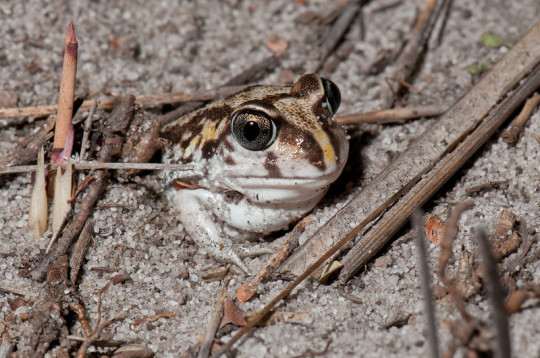
A moaning frog (Heleioporus eyrei) emerges from its burrow in Noranda, Lightning Swamp, Western Australia
by John Anderson
#moaning frog#frogs#amphibians#Heleioporus eyrei#heleioporus#Limnodynastidae#anura#amphibia#chordata#wildlife: australia
732 notes
·
View notes
Text

Giant Burrowing Frog (Heleioporus australiacus).
Image credit: Dr. Jodi Rowley
#dr. jodi rowley#photographer#giant burrowing frog#frog#amphibian#heleioporus australiacus#australian geographic#nature#animal
22 notes
·
View notes
Text
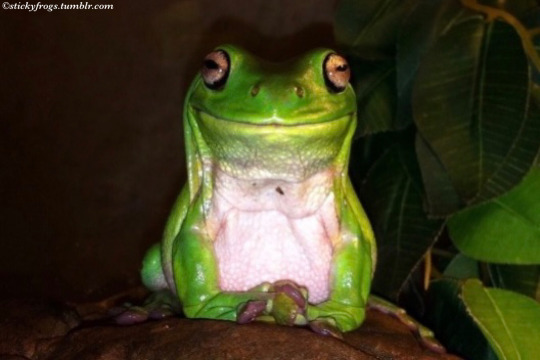
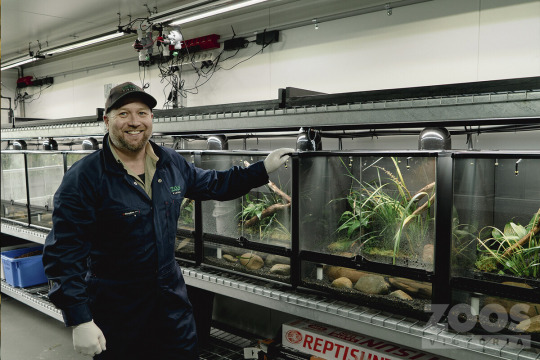
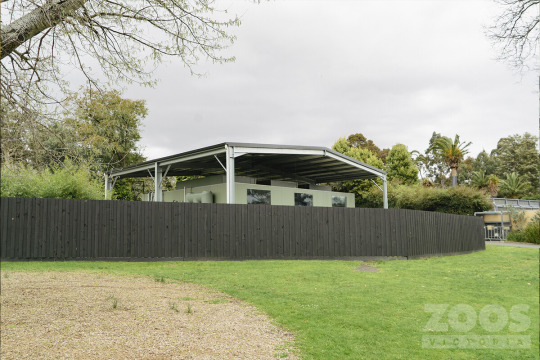
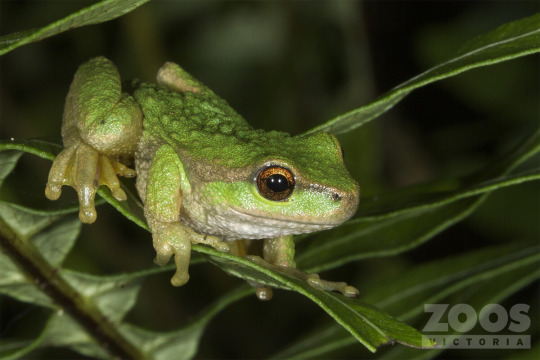
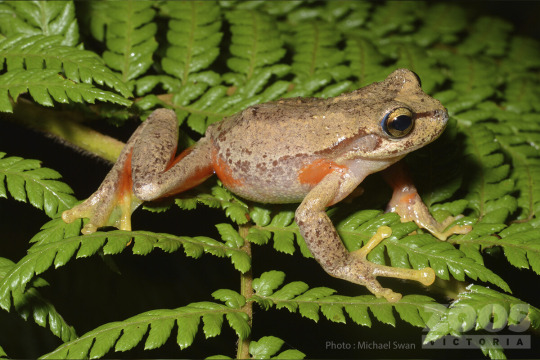
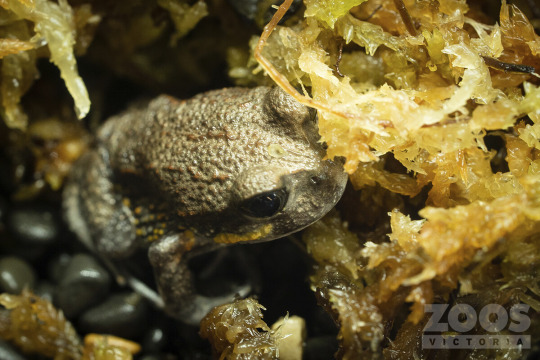
Today we are excited to announce that thanks to the kindness of so many people, a total of $6067 has been donated to the Amphibian Bushfire Recovery Centre at ZoosVictoria in Memory of Gumby!
Our donation will support the specialist keepers and three endangered Victorian frog species:
Spotted Tree Frog (Litoria spenceri)
Watson’s Tree Frog (Litoria watsoni) and
Giant Burrowing Frog (Heleioporus australiacus)
Here is leading amphibian specialist Damian Goodall working at the Recovery Centre and the 3 special frogs! Stay tuned for more! 🐸🐸🐸
196 notes
·
View notes
Text
#FrogFriday:

“he Australian Frog” (Giant Burrowing Frog aka Eastern Owl Frog, Heleioporus australiacus), 1st published image & scientific description by George Shaw & Frederick Nodder in The Naturalist’s Miscellany, Vol. 6, 1794-5, plate 200.
This large, endangered frog species is endemic to coastal areas of New South Wales & Victoria in Australia.
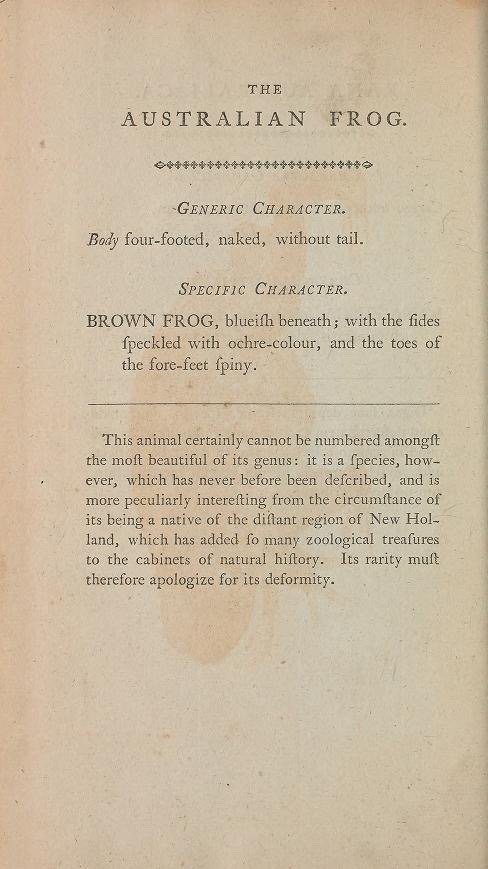
“This animal certainly cannot be numbered amongst the most beautiful of its genus: it is a species, however, which has never before been described, and is more peculiarly interesting from the circumstance of its being a native of the distant region of New Holland, which has added so many zoological treasures to the cabinets of natural history. Its rarity must therefore apologise for its deformity.” 🤨
It should be noted that Shaw was working from a dead specimen - I personally think they’re quite cute, as seen in this photo of a live one! 🥰
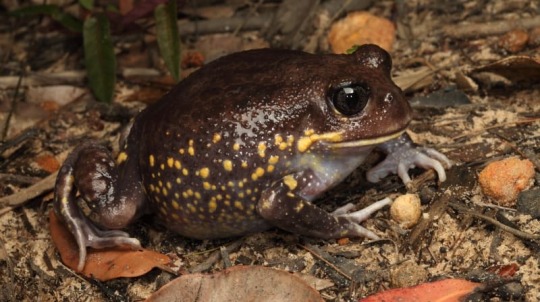
#animals in art#european art#illustration#18th century art#frog#Frog Friday#Frederick Nodder#George Shaw#The Naturalist’s Miscellany#natural history art#scientific illustration#historical sciart#sciart#book plate#heroetology#amphibian#Australian animals#Giant Burrowing Frog#Eastern Owl Frog
11 notes
·
View notes
Note
Top 5 frogs, go.
Oh I am so glad you asked this
1) has to go to the Green Tree Frog (Ranoidea caerulea), absolute classic frog, textbook. Just a little green guy who eats bugs. Love them.
2) the Perons Tree Frog (Litoria peronii) is a wonderful little guy. They have thunder thighs (bright marbled patterning on the inside of their legs that flashes when they jump to make predators think they're poisonous) and are also called the emerald-speckled tree frog, laughing tree frog, and maniacal cackle frog for obvious reasons.
3) goes to the Pobblebonk!! (Limnodynastes dumerilii) I love these little guys!! They go bonk bonk bonk like a banjo, wonderful
4) the Whooping Frog (Heleioporus inornatus) is native to Western Australia and sounds like a little video game character doing a jump, ain't that neat?
5) the Sunset Frog (Spicospina flammocaerulea) is a rare little guy who looks like a molten rock, but they're endangered :( hope they recover soon
Thanks again :)
10 notes
·
View notes
Text

Heleioporus albopunctatus by Matt Summerville
#toad#toads#biology#nature#wildlife#animal#animals#amphibian#amphibians#zoology#herpetology#anura#Limnodynastidae#Heleioporus#Heleioporus albopunctatus
13 notes
·
View notes
Text

today’s funky frog of the day: the moaning frog (Heleioporus eyrei)!!! yet another froggy friend with beautiful big eyes, these lads live in western australia, as well as a few islands off its coast. they’re named after their call, which the males emit from underground.
image by Jodi Rowley
534 notes
·
View notes
Photo

Hooting Frog (Heleioporus barycragus) by Stephen Zozaya Darling Range, Western Australia.
83 notes
·
View notes
Photo


Heleioporus australiacus, or the giant burrowing frog, is a species native to the coast of south east New South Wales and Victoria in Australia. They’re locally known as “eastern owl frogs” due to their mating call, which sounds like an owl’s hoot. Their eggs are laid on the edges of streams during autumn and spring, and are washed into bodies of water following heavy rainfall. Images by David Nixon.
492 notes
·
View notes
Text
New to science
Australasian Journal of Herpetology ® Issue 39, published 12 June 2019
New taxa formally named in Australasian Journal of Herpetology, Issue 39 Published 12 June 2019 New genera (3) (1 frog, 2 lizard) Paraheleioporus Hoser, 2019 (Frog) Cassandracambellea Hoser, 2019 (Gecko Lizard) Malayacolotes Hoser, 2019 (Gecko Lizard) New subgenera (4) (all lizards) Ferehemiphyllodactylus Hoser, 2019 (Gecko Lizard) Maculacruscalotes Hoser, 2019 (Gecko Lizard) Titiwangsacolotes Hoser, 2019 (Gecko Lizard) Williamconnellysaurus Hoser, 2019 (Dragon Lizard) New Species (1 frog, 13 lizards) Philocryphus hoserae Hoser, 2019 (Frog) Malayacolotes cassandracampbellae Hoser, 2019 (Gecko Lizard) Chelosania neilsonnemanni Hoser, 2019 (Dragon Lizard) Tympanocryptis snakebustersorum Hoser, 2019 (Dragon Lizard) Tympanocryptis optus Hoser, 2019 (Dragon Lizard) Tympanocryptis vodafone Hoser, 2019 (Dragon Lizard) Tympanocryptis lachlanheffermani Hoser, 2019 (Dragon Lizard) Tympanocryptis simonknolli Hoser, 2019 (Dragon Lizard) Tympanocryptis deniselivingstoneae Hoser, 2019 (Dragon Lizard) Tympanocryptis karimdaouesi Hoser, 2019 (Dragon Lizard) Tympanocryptis williamconnollyi Hoser, 2019 (Dragon Lizard) Tympanocryptis tonylovelinayi Hoser, 2019 (Dragon Lizard) Tympanocryptis reconnectorum Hoser, 2019 (Dragon Lizard) Tympanocryptis samsungorum Hoser, 2019 (Dragon Lizard) New subspecies (4) (all lizards) Tympanocryptis tetraporophora ianrentoni Hoser, 2019 (Dragon Lizard) Tympanocryptis simonknolli marcusbrummeri Hoser, 2019 (Dragon Lizard) Tympanocryptis karimdaouesi courtneyleitchae Hoser, 2019 (Dragon Lizard) Tympanocryptis reconnectorum clintonlogani Hoser, 2019 (Dragon Lizard) Likely synonyms for genera and subgenera in literature Heleioporus Gray, 1841 (Frog) Hemiphyllodactylus Bleeker, 1860 (Gecko Lizard) Tympanocryptis Peters, 1863 (Gecko Lizard) Likely synonyms for species or subspecies in literature Heleioporus hoserae (Hoser, 2019) (Frog) Hemiphyllodactylus titiwangsaensis Zug, 2010 (Gecko Lizard) Hemiphyllodactylus typus Bleeker, 1860 (Gecko Lizard) Tympanocryptis alexteesi Hoser, 2015 (Dragon Lizard) Tympanocryptis bottomi Hoser, 2015 (Dragon Lizard) Tympanocryptis centralis Sternfeld, 1925 (Dragon Lizard) Tympanocryptis cephalus Günther, 1867 (Dragon Lizard) Tympanocryptis houstoni Storr, 1982 (Dragon Lizard) Tympanocryptis intima Mitchell, 1948 (Dragon Lizard) Tympanocryptis karumba Wells and Wellington, 1985 (Dragon Lizard) Tympanocryptis macra Storr, 1982 (Dragon Lizard) Tympanocryptis markteesi Hoser, 2015 (Dragon Lizard) Tympanocryptis tetraporophora Lucas and Frost, 1895 (Dragon Lizard) Tympanocryptis uniformis Mitchell, 1948 (Dragon Lizard)
#Dragon#Taxonomy#nomenclature#new species#gecko#frog#Tympanocryptis#Heleioporus#hoserae#reconnectorum#optus#vodafone#new to science
0 notes
Photo

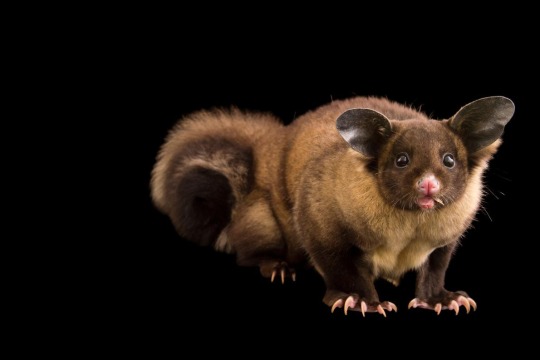


【激増する森林火災、火災に適応した森も再生できない恐れ オーストラリア森林火災は世界的な変化の象徴、研究者らが危惧】 - ナショナルジオグラフィック日本版 : https://natgeo.nikkeibp.co.jp/atcl/news/20/020300074/ 2020.02.04
{{ 図版 1 : オーストラリアの森林火災で焼けてしまった木々。1月9日にバカン近郊で撮影。一部の森は元には戻らないだろうと専門家は言う。(PHOTOGRAPH BY CARLA GOTTGENS, BLOOMBERG/GETTY IMAGES) }}
オーストラリア南東部に広がる高く湿った森、いわゆる湿性高木林には、世界で最も背が高い顕花植物がある。セイタカユーカリだ。その学名Eucalyptus regnansは、ラテン語で「ユーカリの支配者」という意味。この巨木が高さ90メートル以上にも達することを考えると、ぴったりの名前だろう。(参考記事: {{ 「タスマニアの巨木林を守れ」 : https://natgeo.nikkeibp.co.jp/nng/article/news/14/7769/ }} )
オーストラリアに生えるユーカリの多く、とりわけ比較的乾燥した森は、森林火災に耐性があり、炎に包まれてから数週間以内に新芽や新たな枝を出す。だが、こうした火に強い種にも限界はある。
さらに、セイタカユーカリやその近縁種アルパインアッシュ(Eucalyptus delegatensis)の原生林は、火災に対する耐性がより低い。ビクトリア州では、これらの木は伐採や開拓により、すでに著しく減少していた。今季オーストラリア東部を襲った森林火災は、数カ月で10万5000平方キロ以上(本州の面積の半分弱)を焼き、現在、森はさらに大きな危機にさらされている。(参考記事: {{ 「森林火災で火災積乱雲が発生、まるで地獄絵図、豪」 : https://natgeo.nikkeibp.co.jp/atcl/news/20/010800012/ }} )
今回、壊滅的な被害を受けた場所のなかには、過去25年間で4度も火災に見舞われたところがある。そんな目にあえば森は回復できないと、オーストラリア国立大学の生態学者デビッド・リンデンマイヤー氏は言う。
「これまで森林火災は、75?125年に1度のペースでしか発生してきませんでした。今起きているのは、まさに異常事態です」と同氏は話す。「セイタカユーカリは、樹齢15?30年にならないと、森林火災から再生するだけの十分な数の種子を作れません」
森を特徴づけるこうした優占種の喪失は、重大な問題だ。ススイロメンフクロウ(Tyto tenebricosa)、ジャイアントバロウィングフロッグ(Heleioporus australiacus)、もふもふの樹上性有袋類フクロムササビ(Petauroides volans)など、絶滅が危ぶまれる種の重要な生息地となっているからだ。
「元の生態系は、事実上、崩壊してしまいました。何か別のもの、どこにでも生えてくる雑草のような植物の群生地に変わってしまう可能性が高いです」と、チャールズ・ダーウィン大学の保全生物学者ジョン・ウォナースキー氏は話す。「面白みも特徴も少ない植生に収束し、絶滅が危惧される動植物をわずかしか支えられなくなるでしょう」
{{ 図版 2 : ギャラリー:オーストラリア森林火災で深刻な被害を被る動物たち 13点
オオフクロモモンガは、オーストラリア原産の滑空する有袋類の1つで、国際自然保護連合(IUCN)のレッドリストで「近危急種(near-threatened)」に指定されている。森林火災の発生地帯にあるユーカリの森に暮らし、大きな古木に巣を作る。過去3世代で、個体数は30%も減少した。生息地の喪失により、この危機的状況がさらに悪化するかもしれない。(PHOTOGRAPH BY JOEL SARTORE, NATIONAL GEOGRAPHIC PHOTO ARK) : https://natgeo.nikkeibp.co.jp/atcl/gallery/020300815/index.html?P=7 }}
≫――――――≪
オーストラリアの状況は、カリフォルニア、カナダ、ブラジル、ボルネオなど、世界中の森林で起きていることを象徴している。森林火災から繰り返し再生して生き残ってきた森でさえ、気候変動による地球温暖化に伴い、ますます増えて激しくなる森林火災に直面し、回復力を失いつつある。(参考記事: {{ 「森林火災が地球におよぼすこれだけの影響」 : https://natgeo.nikkeibp.co.jp/atcl/news/16/a/062700039/ }} )
先月発表された論文によると、気候変動のせいで、高温と乾燥が進み、異常気象が増え、森林火災の危険性が著しく高まっているという。世界中の植物が生える地域の4分の1超において、森林火災の発生シーズンは過去40年間で20%延びた。
例えば、米カリフォルニア州は、2018年に史上最悪の森林火災に見舞われた。乾燥した地中海性生態系を持つ他の場所、ギリシャやポルトガルなどでも、記録的な森林火災が相次いだ。(参考記事: {{ 「カリフォルニアの山火���はなぜ激しくなっている?」 : https://natgeo.nikkeibp.co.jp/atcl/news/19/102800621/ }} )
熱帯雨林もダメージを受けている。最近の衛星データを見ると、アマゾンの森林破壊がここ11年で最悪のペースで進んでいる。破壊された森の多くでは、土地を開拓するために意図的に火が放たれている。(参考記事: {{ 「アマゾン森林火災、実態は「伐採規制前への逆行」」 : https://natgeo.nikkeibp.co.jp/atcl/news/19/090200509/ }} )
北方林やツンドラでさえ、森林火災は発生している。2019年には、アラスカとシベリアの広大な地域が炎に包まれた。(参考記事: {{ 「北極は数十年で4℃上昇、温暖化は加速モードに」 : https://natgeo.nikkeibp.co.jp/atcl/news/19/120900713/ }} )
「森林火災が発生するとは考えられていなかった場所が、今燃えています」と米ニューメキシコ州ロスアラモスにある米地質調査所フォートコリンズ科学センターで、気候変動が森林に及ぼす影響を研究する生態学者クレイグ・アレン氏は話す。
■《気温の上昇がもたらす悪循環》
世界的な変化の1つが、気温の上昇だとアレン氏は言う。気温が高くなるほど、空気中の水分はより増える。そして、環境から水分を吸収し、土壌が乾燥して、木にストレスがかかる。そのせいで生態系全体がより燃えやすくなるだけでなく、木が昆虫に攻撃される可能性が高まり、枯れ木が増え、森林火災のリスクがますます高まる。
「温暖化により、燃えやすいものが増え、森林火災のシーズンが延びています」と同氏は話す。「北米西部の森林火災シーズンが、30年前より2?3カ月も長くなっているのです」
「深刻な森林火災の発生頻度も増加しています」と、生態系がかく乱にどう反応するかを研究する米コロラド州立大学のカミーユ・スティーブンス=ルーマン氏は言う。「そうした森林火災が発生する頻度は、以前は10年に1度、あるいはもっと少ないくらいでした。ところが今では、少なくとも1年おきに大規模で深刻な森林火災が発生しています」
2019年は、オーストラリアにおける120年の観測史上、最も暑く乾燥した年になった。かつてないほどの干ばつにより、森は乾燥し、火がつきやすくなっていた。森林火災は9月に始まり、12月下旬にピークを迎え、クイーンズランド州、ニューサウスウェールズ州、ビクトリア州の広大な地域が炎に包まれた。
「焼けたところでは、今年の痕跡が何百年も残るでしょう」と西オーストラリア州パースにあるマードック大学の森林火災生態学者ジョー・フォンテーヌ氏は話す。「多くの場所で、湿った森はより乾燥した燃えやすい森になるでしょう」
≫――――――≪
同様に、北米でも森林火災の頻度と激しさが、ますます増大している。そのせいで、今優勢な植生がゆっくりと姿を消しつつあると、アレン氏は言う。
北米では、ポンデローサマツ(Pinus Ponderosa)の森で発生する火災の大部分を100年以上にわたり抑えるように管理してきた結果、樹木の密度が大幅に増加した。だが、異常気象により、森林火災を抑えることが難しくなっている。一度火がつけば非常に激しく燃え広がり、森林火災の後に次世代の種をまくのに不可欠な「マザーツリー(母なる木)」をも枯らしてしまう。
「ポンデローサマツの森は、低層にある松の葉や草を焼くような、よく起きる小さな森林火災に完全に適応しています」と同氏は話す。「しかし、炎が激しさを増し、樹冠にまで達する場合には耐えられません。成熟しきった個体として死を迎え、再生しないのです」
{{ 図版 3 : 2009年にカリフォルニア州のエンジェルス国有林バーリーフラッツで起きた大規模な森林火災「ステーションファイア」の焼け跡のうち、ポンデローサマツの苗木を植えたエリアを調べる米森林局「ステーションファイア森林再生プロジェクト」のリーダー、スティーブ・ベア氏。(PHOTOGRAPH BY ALLEN J. SCHABEN, LOS ANGELES TIMES/GETTY IMAGES) }}
ポンデローサマツの種子が、約150メートルを超えて飛ぶことはめったにない。このため、木が枯れると、大きな隙間が残る。北米西部の山岳林の一部では、「トウヒ、モミ、マツなどの針葉樹林から、草や低木が大部分を占める地帯へと、大きく姿を変えつつあります」とアレン氏は話す。
■《積み重なるかく乱》
森林が火災から完全に回復できていないところでは、その生態系に依存する動物種が、ますます多くの試練に直面することになる。問題の1つは、森林火災に苦しんでいる種が、干ばつ、熱波、害虫のまん延など、他の気候関連の影響によるストレスをすでに受けている場合が多いことだ。こうしたかく乱の積み重ねが回復をさらに悪化させるかどうかは、「決定的かつ極めて重要な質問」だと、フォンテーヌ氏は言う。
同氏のチームは、西オーストラリア州に生息する火に耐性のある低木、Banksia hookerianaを研究している。その種子は松ぼっくり状のものに入っており、なんと森林火災の後にのみ開くという。だが、気候変動により、1980年代に比べて種子の数が50%も減少したことがわかった。
「このような数字を見ると、頬を叩かれたような気になります。気候変動が机上の空論ではなく、現実のものだと実感します」とフォンテーヌ氏は話す。
この傾向は、ニシアメリカフクロウ(Strix occidentalis)やカナダオオヤマネコ(Lynx canadensis)など、北米の原生林を好む多くの動物にとって悪いニュースだと、スティーブンス=ルーマン氏は言う。オーストラリアの現在の森林火災により、約50種の絶滅危惧種の生息地が、80%以上もこれまでに焼けてしまった。カンガルー島に固有の肉食有袋類Sminthopsis aitkeniや、火に弱いハーブTrachymene scapigeraなど、一部の種はすべての生息域で壊滅的な被害を受けた。
こうした個々の動植物が地域から消えると、様々な種の間で起こる重要な相互作用も失われる可能性がある。生態系全体の機能や森林火災からの回復に、予期せぬ影響が出るかもしれない。
≫――――――≪
ポルトガルでは、森林火災の後、野花が大量に咲き、元に戻ったかのように見えた。だが、2019年に発表された論文によると、授粉に不可欠なガが、森林火災が起きていない地域に比べ、わずか5分の1の花粉しか運んでおらず、再生は前途多難であることがわかった。
しかしながら、森林火災が増えると、すべての種が減るわけではない。北米では、100年以上森林火災を抑え続けた結果、セグロミユビゲラ(Picoides arcticus)が減少してしまった。彼らは、焼けた木に紛れるような保護色をしているのだ。ところが、森林火災が増えた現在、個体数は回復しつつあると、スティーブンス=ルーマン氏は言う。
オーストラリアでは、オオトカゲ、一部の猛禽類、外来のネコやキツネなど、多くの捕食者が、獲物を求めて森林火災の跡を積極的に探している。遮るもののない地で露わになった生存者を狩るためだ。
森林火災に見舞われた地で繁栄する他の動物には、ナガヒラタタマムシ属の甲虫が含まれる。焼けたばかりの木に卵を産み、幼虫はその木で育つ。もっと一般的な種のなかにも、森林火災の後で利益を得るものがいると、スティーブンス=ルーマン氏は付け加える。
「森が開け、低木や草が豊富にあるとなれば、シカは回復するはずです」
■《「これは大きな挑戦です」》
森林火災は規模と激しさを増し、ますます頻発するようになりつつある。だが、状況にまったく希望がないわけではないと、専門家は口をそろえる。自然災害がより頻発する世界では、より野心的かつクリエイティブに、冒険心を持って保全に取り組む必要があると、ウォナースキー氏は言う。
「これは大きな挑戦です。すべてのことに短期的な解決策があるわけではないのです」
例えば、森林火災後の種まきは、北米ではよく行われるが、オーストラリアではめったに行われない。ヘリコプターからセイタカユーカリの種をまくことが、将来検討されるかもしれないと、リンデンマイヤー氏は言う。より急進的なアイデアとしては、火に耐性のある外来種の植林が挙げられる。また、土地を管理することも、解決策の1つだ。
「フィンランドには、素晴らしいことわざがあります。『火は良き僕だが、悪しき主にもなる』です」とスティーブンス=ルーマン氏は語る。つまり、人が火を道具として有効に利用できるのは、火を制御下に置いている時だけだ。
オーストラリアの先住民アボリジニは、何万年もの間、頻繁に小規模な野焼きを行うことで、枯れ草や落ち葉などの燃えやすいものを減らし、大規模な森林火災を効果的に防いできた。現在、こうした伝統的な野焼きへの回帰を呼びかける声が高まりつつある。
「米国で発生した森林火災の98%は抑え込まれます。つまり、大規模な森林火災に発展し、ニュースになるのは、たったの2%だけなのです」とスティーブンス=ルーマン氏は話す。「しかし、この98%を有効に利用して、燃えやすいものをあらかじめ焼いてしまい、森をモザイク状にすれば、大規模かつ猛烈な森林火災を阻止できる可能性があります」
それでも、気候変動��待ったなしで進行中であり、干ばつや熱波、その他の森林火災の原因の増加は避けられそうにない。今から数十年後、2019年は普通の年だった、あるいは比較的涼しく雨の多い年だったとさえ言われるようになるかもしれないと、アレン氏は語る。
「あっという間に忍び寄ってきた、本当に不吉な未来です」と、ウォナースキー氏は付け加える。「私たちの愛すべき生態系の多くが変貌し始めているのを、目の当たりにしています。我々にとっては悲劇ですが、我々の子孫にとっては悲劇では済まされません」
{{ 図版 4 : ギャラリー:オーストラリア森林火災で深刻な被害を被る動物たち 13点
IUCNのレッドリストで「近絶滅種(critically endangered)」に指定されているブーラミスは、わずか2000~3000匹しか野生に残されていない。ビクトリア州北部やニューサウスウェールズ州南部のいくつかの山にのみ生息する。完全に高山の生息地で生活するオーストラリアで唯一の哺乳類だが、その生息地の多くは森林火災で燃えてしまった。森林火災を生き延びたものは、食糧不足に直面し、木々が焼け落ちた地で効率よく狩りをする野生化したネコやキツネの餌食となっている。(参考記事:「絶滅寸前の有袋類、化石の地への移住で保護へ、豪」)(PHOTOGRAPH BY JOEL SARTORE, NATIONAL GEOGRAPHIC PHOTO ARK) : https://natgeo.nikkeibp.co.jp/atcl/gallery/020300815/index.html?P=11 }}
文=JOHN PICKRELL/訳=牧野建志
0 notes
Text
Cane toad
Cane toad
For other uses, see Cane toads (disambiguation). The cane toad (Rhinella marina), also known as the giant neotropical toad or marine toad, is a large, terrestrial true toad which is native to South and mainland Middle America, but has been introduced to various islands throughout Oceania and the Caribbean, as well as northern Australia. It is a member of the genus Rhinella, but was formerly in the genus Bufo, which includes many different true toad species found throughout Central and South America. The cane toad is a prolific breeder; females lay single-clump spawns with thousands of eggs. Its reproductive success is partly because of opportunistic feeding: it has a diet, unusual among anurans, of both dead and living matter. Adults average 10–15 cm (3.9–5.9 in) in length; the largest recorded specimen weighed 2.65 kg (5.8 lb) with a length of 38 cm (15 in) from snout to vent. The cane toad is an old species. A fossil toad (specimen UCMP 41159) from the La Venta fauna of the late Miocene of Colombia is indistinguishable from modern cane toads from northern South America. It was discovered in a floodplain deposit, which suggests the R. marina habitat preferences have always been for open areas. The cane toad has poison glands, and the tadpoles are highly toxic to most animals if ingested. Because of its voracious appetite, the cane toad has been introduced to many regions of the Pacific and the Caribbean islands as a method of agricultural pest control. The species derives its common name from its use against the cane beetle (Dermolepida albohirtum). The cane toad is now considered a pest and an invasive species in many of its introduced regions; of particular concern is its toxic skin, which kills many animals—native predators and otherwise—when ingested. Taxonomy Originally, the cane toads were used to eradicate pests from sugarcane, giving rise to their common name. The cane toad has many other common names, including "giant toad" and "marine toad"; the former refers to its size and the latter to the binomial name, R. marina. It was one of many species described by Linnaeus in his 18th-century work Systema Naturae (1758). Linnaeus based the specific epithet marina on an illustration by Dutch zoologist Albertus Seba, who mistakenly believed the cane toad to inhabit both terrestrial and marine environments. Other common names include "giant neotropical toad", "Dominican toad", "giant marine toad", and "South American cane toad". In Trinidadian English, they are commonly called crapaud, the French word for toad. The genus Rhinella is considered to constitute a distinct genus of its own, thus changing the scientific name of the cane toad. In this case, the specific name marinus (masculine) changes to marina (feminine) to conform with the rules of gender agreement as set out by the International Code of Zoological Nomenclature, changing the binomial name from Bufo marinus to Rhinella marina; the binomial Rhinella marinus was subsequently introduced as a synonym through misspelling by Pramuk, Robertson, Sites, and Noonan (2008). Though controversial (with many traditional herpetologists still using Bufo marinus) the binomial Rhinella marina is gaining in acceptance with such bodies as the IUCN, Encyclopaedia of Life, Amphibian Species of the World and increasing numbers of scientific publications adopting its usage. A large, adult cane toad, showing the light colouration present in some specimens of the species Light-coloured cane toad In Australia, the adults may be confused with large native frogs from the genera Limnodynastes, Cyclorana, and Mixophyes. These species can be distinguished from the cane toad by the absence of large parotoid glands behind their eyes and the lack of a ridge between the nostril and the eye. Cane toads have been confused with the giant burrowing frog (Heleioporus australiacus), because both are large and warty in appearance; however, the latter can be readily distinguished from the former by its vertical pupils and its silver-grey (as opposed to gold) irises. Juvenile cane toads may be confused with species of the Uperoleia genus, but their adult colleagues can be distinguished by the lack of bright colouring on the groin and thighs. In the United States, the cane toad closely resembles many bufonid species. In particular, it could be confused with the southern toad (Bufo terrestris), which can be distinguished by the presence of two bulbs in front of the parotoid glands. Description A juvenile cane toad, showing many of the features of the adult toads, but without the large parotoid glands Young cane toad The cane toad is very large; the females are significantly longer than males, reaching an average length of 10–15 cm (3.9–5.9 in). "Prinsen", a toad kept as a pet in Sweden, is listed by Guinness World Records as the largest recorded specimen. It reportedly weighed 2.65 kg (5.84 lb) and measured 38 cm (15 in) from snout to vent, or 54 cm (21 in) when fully extended. Larger toads tend to be found in areas of lower population density. They have a life expectancy of 10 to 15 years in the wild, and can live considerably longer in captivity, with one specimen reportedly surviving for 35 years. The skin of the cane toad is dry and warty. It has distinct ridges above the eyes, which run down the snout. Individual cane toads can be grey, yellowish, red-brown, or olive-brown, with varying patterns. A large parotoid gland lies behind each eye. The ventral surface is cream-coloured and may have blotches in shades of black or brown. The pupils are horizontal and the irises golden. The toes have a fleshy webbing at their base, and the fingers are free of webbing. Typically, juvenile cane toads have smooth, dark skin, although some specimens have a red wash. Juveniles lack the adults' large parotoid glands, so they are usually less poisonous. The tadpoles are small and uniformly black, and are bottom-dwellers, tending to form schools. Tadpoles range from 10 to 25 mm (0.39 to 0.98 in) in length. Ecology, behavior, and life history The common name "marine toad" and the scientific name Rhinella marina suggest a link to marine life, but the adult cane toad is entirely terrestrial, only venturing to fresh water to breed. However, laboratory experiments suggest that tadpoles can tolerate salt concentrations equivalent to 15% of seawater (~5.4‰), and recent field observations found living tadpoles and toadlets at salinities of 27.5‰ on Coiba Island, Panama. The cane toad inhabits open grassland and woodland, and has displayed a "distinct preference" for areas modified by humans, such as gardens and drainage ditches. In their native habitats, the toads can be found in subtropical forests, although dense foliage tends to limit their dispersal. The cane toad begins life as an egg, which is laid as part of long strings of jelly in water. A female lays 8,000–25,000 eggs at once and the strings can stretch up to 20 m (66 ft) in length. The black eggs are covered by a membrane and their diameter is about 1.7–2.0 mm (0.067–0.079 in). The rate at which an egg grows into a tadpole increases with temperature. Tadpoles typically hatch within 48 hours, but the period can vary from 14 hours to almost a week. This process usually involves thousands of tadpoles—which are small, black, and have short tails—forming into groups. Between 12 and 60 days are needed for the tadpoles to develop into juveniles, with four weeks being typical. Similarly to their adult counterparts, eggs and tadpoles are toxic to many animals. When they emerge, toadlets typically are about 10–11 mm (0.39–0.43 in) in length, and grow rapidly. While the rate of growth varies by region, time of year, and gender, an average initial growth rate of 0.647 mm (0.0255 in) per day is seen, followed by an average rate of 0.373 mm (0.0147 in) per day. Growth typically slows once the toads reach sexual maturity. This rapid growth is important for their survival; in the period between metamorphosis and subadulthood, the young toads lose the toxicity that protected them as eggs and tadpoles, but have yet to fully develop the parotoid glands that produce bufotoxin. Because they lack this key defence, only an estimated 0.5% of cane toads reach adulthood. As with rates of growth, the point at which the toads become sexually mature varies across different regions. In New Guinea, sexual maturity is reached by female toads with a snout–vent length between 70 and 80 mm (2.8 and 3.1 in), while toads in Panama achieve maturity when they are between 90 and 100 mm (3.5 and 3.9 in) in length. In tropical regions, such as their native habitats, breeding occurs throughout the year, but in subtropical areas, breeding occurs only during warmer periods that coincide with the onset of the wet season. The cane toad is estimated to have a critical thermal maximum of 40–42 °C (104–108 °F) and a minimum of around 10–15 °C (50–59 °F). The ranges can change due to adaptation to the local environment. The cane toad has a high tolerance to water loss; some can withstand a 52.6% loss of body water, allowing them to survive outside tropical environments. Most frogs identify prey by movement, and vision appears to be the primary method by which the cane toad detects prey; however, the cane toad can also locate food using its sense of smell. They eat a wide range of material; in addition to the normal prey of small rodents, reptiles, other amphibians, birds, and even bats and a range of invertebrates, they also eat plants, dog food, and household refuse. An adult cane toad with dark colouration, as found in El Salvador: The parotoid gland is prominently displayed on the side of the head. Specimen from El Salvador: The large parotoid glands are visible behind the eyes. The skin of the adult cane toad is toxic, as well as the enlarged parotoid glands behind the eyes, and other glands across their backs. When the toads are threatened, their glands secrete a milky-white fluid known as bufotoxin. Components of bufotoxin are toxic to many animals; even human deaths have been due to the consumption of cane toads. Bufotenin, one of the chemicals excreted by the cane toad, is classified as a class-1 drug under Australian law, alongside heroin and cannabis. The effects of bufotenin are thought to be similar to those of mild poisoning; the stimulation, which includes mild hallucinations, lasts for less than an hour. As the cane toad excretes bufotenin in small amounts, and other toxins in relatively large quantities, toad licking could result in serious illness or death. In addition to releasing toxin, the cane toad is capable of inflating its lungs, puffing up, and lifting its body off the ground to appear taller and larger to a potential predator. Poisonous sausages containing toad meat are being trialled in the Kimberley (Western Australia) to try to protect native animals from cane toads' deadly impact. The Western Australian Department of Environment and Conservation has been working with the University of Sydney to develop baits to train native animals not to eat the toads. By blending bits of toad with a nausea-inducing chemical, the baits train the animals to stay away from the amphibians. Researcher David Pearson says trials run in laboratories and in remote parts of the Kimberley region of WA are looking promising, although the baits will not solve the cane toad problem altogether. Many species prey on the cane toad and its tadpoles in its native habitat, including the broad-snouted caiman (Caiman latirostris), the banded cat-eyed snake (Leptodeira annulata), eels (family Anguillidae), various species of killifish, the rock flagtail (Kuhlia rupestris), some species of catfish (order Siluriformes), some species of ibis (subfamily Threskiornithinae), and Paraponera clavata (bullet ants). Predators outside the cane toad's native range include the whistling kite (Haliastur sphenurus), the rakali (Hydromys chrysogaster), the black rat (Rattus rattus) and the water monitor (Varanus salvator). The tawny frogmouth (Podargus strigoides) and the Papuan frogmouth (Podargus papuensis) have been reported as feeding on cane toads; some Australian crows (Corvus spp.) have also learned strategies allowing them to feed on cane toads, such as using their beak to flip toads onto their back. Opossums of the Didelphis genus likely can eat cane toads with impunity. Meat ants are unaffected by the cane toads' toxins, and therefore are able to kill them. The cane toad's normal response to attack is to stand still and let their toxin kill the attacker, which allows the ants to attack and eat the toad. Distribution The cane toad is native to the Americas, and its range stretches from the Rio Grande Valley in South Texas to the central Amazon and southeastern Peru. This area encompasses both tropical and semiarid environments. The density of the cane toad is significantly lower within its native distribution than in places where it has been introduced. In South America, the density was recorded to be 20 adults per 100 m (109 yd) of shoreline, 1 to 2% of the density in Australia. Introductions The cane toad has been introduced to many regions of the world—particularly the Pacific—for the biological control of agricultural pests. These introductions have generally been well documented, and the cane toad may be one of the most studied of any introduced species. Before the early 1840s, the cane toad had been introduced into Martinique and Barbados, from French Guiana and Guyana. An introduction to Jamaica was made in 1844 in an attempt to reduce the rat population. Despite its failure to control the rodents, the cane toad was introduced to Puerto Rico in the early 20th century in the hope that it would counter a beetle infestation ravaging the sugarcane plantations. The Puerto Rican scheme was successful and halted the economic damage caused by the beetles, prompting scientists in the 1930s to promote it as an ideal solution to agricultural pests. As a result, many countries in the Pacific region emulated the lead of Puerto Rico and introduced the toad in the 1930s. There are introduced populations in Australia, Florida, Papua New Guinea, the Philippines, the Ogasawara, Ishigaki Island and the Daitō Islands of Japan, most Caribbean islands, Fiji and many other Pacific islands, including Hawaii. Since then, the cane toad has become a pest in many host countries, and poses a serious threat to native animals. Main article: Cane toads in Australia A map of Australia with the cane toad's distribution highlighted: The area follows the northeastern coast of Australia, ranging from the Northern Territory through to the north end of New South Wales. Distribution of the cane toad in Australia (note: map out of date – current range includes northern WA, northern NSW and SA) Following the apparent success of the cane toad in eating the beetles threatening the sugarcane plantations of Puerto Rico, and the fruitful introductions into Hawaii and the Philippines, a strong push was made for the cane toad to be released in Australia to negate the pests ravaging the Queensland cane fields. As a result, 102 toads were collected from Hawaii and brought to Australia. After an initial release in August 1935, the Commonwealth Department of Health decided to ban future introductions until a study was conducted into the feeding habits of the toad. The study was completed in 1936 and the ban lifted, when large-scale releases were undertaken; by March 1937, 62,000 toadlets had been released into the wild. The toads became firmly established in Queensland, increasing exponentially in number and extending their range into the Northern Territory and New South Wales. Recently, the toads have made their way into Western Australia and one has even been found on the far western coast in Broome. However, the toad was generally unsuccessful in reducing the targeted grey-backed beetles, in part because the cane fields provided insufficient shelter for the predators during the day, in part because the beetles live at the tops of sugar cane – and cane toads are not good climbers. Since its original introduction, the cane toad has had a particularly marked effect on Australian biodiversity. The population of a number of native predatory reptiles has declined, such as the varanid lizards Varanus mertensi, V. mitchelli, and V. panoptes, the land snakes Pseudechis australis and Acanthophis antarcticus, and the crocodile species Crocodylus johnstoni; in contrast, the population of the agamid lizard Amphibolurus gilberti—known to be a prey item of V. panoptes—has increased. The cane toad was introduced to various Caribbean islands to counter a number of pests infesting local crops. While it was able to establish itself on some islands, such as Barbados, Jamaica, and Puerto Rico, other introductions, such as in Cuba before 1900 and in 1946, and on the islands of Dominica and Grand Cayman, were unsuccessful. The earliest recorded introductions were to Barbados and Martinique. The Barbados introductions were focused on the biological control of pests damaging the sugarcane crops, and while the toads became abundant, they have done even less to control the pests than in Australia. The toad was introduced to Martinique from French Guiana before 1944 and became established. Today, they reduce the mosquito and mole cricket populations. A third introduction to the region occurred in 1884, when toads appeared in Jamaica, reportedly imported from Barbados to help control the rodent population. While they had no significant effect on the rats, they nevertheless became well established. Other introductions include the release on Antigua—possibly before 1916, although this initial population may have died out by 1934 and been reintroduced at a later date— and Montserrat, which had an introduction before 1879 that led to the establishment of a solid population, which was apparently sufficient to survive the Soufrière Hills volcano eruption in 1995. In 1920, the cane toad was introduced into Puerto Rico to control the populations of white-grub (Phyllophaga spp.), a sugarcane pest. Before this, the pests were manually collected by humans, so the introduction of the toad eliminated labor costs. A second group of toads was imported in 1923, and by 1932, the cane toad was well established. The population of white-grubs dramatically decreased, and this was attributed to the cane toad at the annual meeting of the International Sugar Cane Technologists in Puerto Rico. However, there may have been other factors. The six-year period after 1931—when the cane toad was most prolific, and the white-grub saw dramatic decline—saw the highest-ever rainfall for Puerto Rico. Nevertheless, the cane toad was assumed to have controlled the white-grub; this view was reinforced by a Nature article titled "Toads save sugar crop", and this led to large-scale introductions throughout many parts of the Pacific. The cane toad has been spotted in Carriacou and Dominica, the latter appearance occurring in spite of the failure of the earlier introductions. On September 8, 2013, the cane toad was also discovered on the island of New Providence in the Bahamas. R. marina in the Philippines are referred to as kamprag, a corruption of 'American frog'. The cane toad was first introduced deliberately into the Philippines in 1930 as a biological control agent of pests in sugarcane plantations. This was done after the success of the experimental introductions into Puerto Rico. It subsequently became the most ubiquitous amphibian in the islands. It still retains the common name of bakî or kamprag in the Visayan languages, a corruption of 'American frog', referring to its origins. It is also commonly known as "bullfrog" in Philippine English. The cane toad was introduced into Fiji to combat insects that infested sugarcane plantations. The introduction of the cane toad to the region was first suggested in 1933, following the successes in Puerto Rico and Hawaii. After considering the possible side effects, the national government of Fiji decided to release the toad in 1953, and 67 specimens were subsequently imported from Hawaii. Once the toads were established, a 1963 study concluded, as the toad's diet included both harmful and beneficial invertebrates, it was considered "economically neutral". Today, the cane toad can be found on all major islands in Fiji, although they tend to be smaller than their counterparts in other regions. The cane toad was successfully introduced into New Guinea to control the hawk moth larvae eating sweet potato crops. The first release occurred in 1937 using toads imported from Hawaii, with a second release the same year using specimens from the Australian mainland. Evidence suggests a third release in 1938, consisting of toads being used for human pregnancy tests—many species of toad were found to be effective for this task, and were employed for about 20 years after the discovery was announced in 1948. Initial reports argued the toads were effective in reducing the levels of cutworms and sweet potato yields were thought to be improving. As a result, these first releases were followed by further distributions across much of the region, although their effectiveness on other crops, such as cabbages, has been questioned; when the toads were released at Wau, the cabbages provided insufficient shelter and the toads rapidly left the immediate area for the superior shelter offered by the forest. A similar situation had previously arisen in the Australian cane fields, but this experience was either unknown or ignored in New Guinea. The cane toad has since become abundant in rural and urban areas. The cane toad naturally exists in South Texas, but attempts (both deliberate and accidental) have been made to introduce the species to other parts of the country. These include introductions to Florida and to the islands of Hawaii, as well as largely unsuccessful introductions to Louisiana. Initial releases into Florida failed. Attempted introductions before 1936 and 1944, intended to control sugarcane pests, were unsuccessful as the toads failed to proliferate. Later attempts failed in the same way. However, the toad gained a foothold in the state after an accidental release by an importer at Miami International Airport in 1957, and deliberate releases by animal dealers in 1963 and 1964 established the toad in other parts of Florida. Today, the cane toad is well established in the state, from the Keys to north of Tampa, and they are gradually extending further northward. In Florida, the toad is a regarded as a threat to native species and pets; so much so, the Florida Fish and Wildlife Conservation Commission recommends residents kill them. A selection of cane toad merchandise, including key rings made from their legs, a coin purse made from the head, front limbs and body of a toad, and a stuffed cane toad Cane toad merchandise Around 150 cane toads were introduced to Oahu in Hawaii in 1932, and the population swelled to 105,517 after 17 months. The toads were sent to the other islands, and more than 100,000 toads were distributed by July 1934; eventually over 600,000 were transported. Uses Other than the previously mentioned use as a biological control for pests, the cane toad has been employed in a number of commercial and noncommercial applications. Traditionally, within the toad's natural range in South America, the Embera-Wounaan would "milk" the toads for their toxin, which was then employed as an arrow poison. The toxins may have been used as an entheogen by the Olmec people. The toad has been hunted as a food source in parts of Peru, and eaten after the careful removal of the skin and parotoid glands. When properly prepared, the meat of the toad is considered healthy and as a source of omega-3 fatty acids. More recently, the toad's toxins have been used in a number of new ways: bufotenin has been used in Japan as an aphrodisiac and a hair restorer, and in cardiac surgery in China to lower the heart rates of patients. New research has suggested that the cane toad's poison may have some applications in treating prostate cancer. Other modern applications of the cane toad include pregnancy testing, as pets, laboratory research, and the production of leather goods. Pregnancy testing was conducted in the mid-20th century by injecting urine from a woman into a male toad's lymph sacs, and if spermatozoa appeared in the toad's urine, the patient was deemed to be pregnant. The tests using toads were faster than those employing mammals; the toads were easier to raise, and, although the initial 1948 discovery employed Bufo arenarum for the tests, it soon became clear that a variety of anuran species were suitable, including the cane toad. As a result, toads were employed in this task for around 20 years. As a laboratory animal, the cane toad is regarded as ideal; they are plentiful, and easy and inexpensive to maintain and handle. The use of the cane toad in experiments started in the 1950s, and by the end of the 1960s, large numbers were being collected and exported to high schools and universities. Since then, a number of Australian states have introduced or tightened importation regulations. Even dead toads have value. Cane toad skin has been made into leather and novelty items; stuffed cane toads, posed and accessorised, have found a home in the tourist market, and attempts have been made to produce fertiliser from their bodies. Invasive species When the cane toad is introduced to a new ecosystem, it poses a serious threat to native species. Classified as an invasive species in over 20 countries, there are multiple reports of the cane toad moving into a new area to be followed by a decline in the biodiversity in that region. The most documented region of the cane toad's invasion and subsequent effect on native species is Australia, where multiple surveys and observations of the toad's conquest have been completed. The best way to illustrate this effect is through the plight of the northern quoll, as well as Mertens' water monitor, a large lizard native to South and Southeast Asia. Two sites were chosen to study the effects of cane toads on the northern quoll, one of which was at Mary River ranger station, which is located in the southern region of Kakadu National Park. The other site was located at the north end of the park. In addition to these two sites, there was a third site located at the East Alligator ranger station, and this site was used as a control site, where the cane toads would not interact with the northern quoll population. Monitoring of the quoll population began at the Mary River ranger station using radio tracking in 2002, months before the first cane toads arrived at the site. After the arrival of the cane toads, the population of northern quolls in the Mary River site plummeted between October and December 2002, and by March 2003, the northern quoll appeared to be extinct in this section of the park, as there were no northern quolls caught in the trapping trips in the following two months. In contrast, the population of northern quolls in the control site at the East Alligator ranger station remained relatively constant, not showing any symptoms of declining. The evidence from the Kakadu National Park is compelling not only because of the timing of the population of northern quolls plummeting just months after the arrival of the cane toad, but also because in the Mary River region 31% of mortalities within the quoll population were attributed to lethal toxic ingestion, as there were no signs of disease, parasite infestation, or any other obvious changes at the site that could have caused such a rapid decline. The most obvious piece of evidence which supports the hypothesis that the invasion of the cane toads caused the local extinction of the northern quoll is that the closely monitored population of the control group, in the absence of cane toads, showed no signs of decline. In the case of the Mertens' water monitor, more commonly known as Merten's water monitor, there was only one region that was monitored, but over the course of 18 months. This region is located 70 kilometers south of Darwin, at the Manton Dam Recreation Area. Within the Manton Dam Recreation Area, there were 14 sites set up to survey the population of water monitors, measuring abundance and site occupancy at each one. Seven surveys were conducted, each of which ran for four weeks and included 16 site visits, where each site was sampled twice per day for two consecutive days throughout the 4 weeks. Each site visit occurred between 7:30 -10:30 AM, and 4:00- 7:00 PM, when Varanus mertensi can be viewed sunbathing on the shore or wrapped around a tree branch close to shore. The whole project lasted from December 2004 to May 2006, and unveiled a total of 194 sightings of Varanus mertensi in 1568 site visits. Of the seven surveys, abundance was highest during the second survey, which took place in February 2005, two months into the project. Following this measurement, the abundance declined in the next 4 surveys, before declining sharply after the second to last survey in February 2006. In the final survey taken in May 2006, there were only two Varanus mertensi observed. Cane toads were first recorded in the region of study during the second survey during February 2005, also when the water monitor abundance was at its highest over the course of the study. Numbers of the cane toad population stayed low for the next year after introduction, and then skyrocketed to its peak in the last survey during May 2006. When you compare the two populations side by side one can see clearly that the onset of the cane toads had an immediate negative impact on the Varanus mertensi, as their population began to drop in February 2005, which was when the first cane toads entered the Manton Dam Recreation Area. At the end of the study, some scattered population of water monitors remained in the upper sites of the Manton Dam, which suggests that local extinctions occurred at certain shoreline sites within Manton Dam, but a complete extinction of the population did not occur. source - Wikipedia Dear friends, if you liked our post, please do not forget to share and comment like this. If you want to share your information with us, please send us your post with your name and photo at [email protected]. We will publish your post with your name and photo. thanks for joining us www.rbbox.in
from Blogger https://ift.tt/2N3FKdR
0 notes
Photo

http://frogs-are-awesome.tumblr.com/post/157953582608/frogs-are-awesome-a-moaning-frog-heleioporus
0 notes
Photo

Cornufer vitiensis by Heleioporus
#Anura#Ceratobatrachidae#Cornufer#Cornufer vitiensis#frog#frogs#animal#animals#biology#nature#wildlife#amphibian#amphibians#zoology#herpetology#herps#fauna#critter#critters
26 notes
·
View notes
Photo

Western Spotted Frog - Heleioporus albopunctatus
Heleioporus albopunctatus (Myobatrachidae) is a species of fat, globular burrowing frog, with granular skin, rather stubby limbs and toes with only rudiments of webbing. The body is chocolate-brown above; the back, head, sides and limbs are marked with scattered large white or yellow spots.
Endemic to Australia, this chubby frog is largely restricted to coast and ranges of south-western Australia.
References: [1] -[2]
Photo credit: ©Stephen Zozaya | Locality: Watheroo, Western Australia (2013)
#nature#animals#western spotted frog#heleioporus albopunctatus#heleioporus#australia#fauna#wildlife#frog#amphibia#anura#myobatrachidae#zoology#original
192 notes
·
View notes
Photo


A Moaning frog (Heleioporus eyrei), photographed by Stephen Zozaya.
Perth, Western Australia.
#moaning frog#Heleioporus eyrei#Heleioporus#Myobatrachidae#Australian ground frogs#frog#frogs#animals#anura#amphibians
2K notes
·
View notes